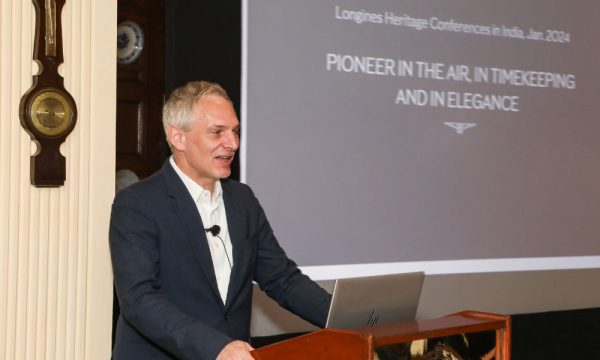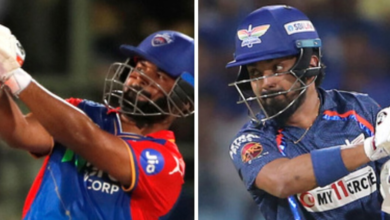Tracking Time: Longines And India

Longines’s storied history is unrivalled among major global watch brands. Because of its meticulous record keeping, and a carefully preserved inventory that stocks watch spares going back to the days of the company’s founding in the 19th century, it can repair watches that are more than a century old. And as the Head of Brand Heritage and member of the Management Board of Longines, Daniel Hug is the official keeper of the brand’s illustrious past. He has been travelling around the world recently talking about Longines’s history, exhibiting key products from the past, and meeting vintage Longines watch collectors. At his Delhi stopover, he spoke exclusively to Man’s World magazine.
Man’s World: As the resident historian of the brand can you elaborate on Longines’s long association with India, which goes back a century or even more?
Daniel Hug: Yes. Longines started to sell watches in India as early as 1878. That was the time when we still had the British empire and the oldest watch we found in India was Longines pocket watch in silver from 1884 in Mumbai. And what’s amazing is really that this watch, which is 140 years old, is still in working condition.
It’s a long history that connects Longines to India. And, what I found really impressive, is that Longines made even special watches just for India. Like the Pilot’s watch from 1950, a huge watch of 44 millimetres, is absolutely shockproof, anti-magnetic, highly resistant, and very accurate. And there are some special features like a second hand, that you can see moving during the night because there is a luminous mask on the tip of the hand. It’s a feature that you see normally on the dive watches, not on pilot’s watches. But it comes from aviation. The watch is missing in our museum, and at the moment, I’m on the hunt. I’m searching for exactly such a watch because I want to have it in our museum.
This big Indian watch is an important watch for us. The engravings on the movement are just amazing. The engraving on these types of watches was directly on the bridge of the movement. So, I want to have that in the museum as well. Some of our collectors have it. That’s why I know the watch.
MW: Do you get requests from Indian owners of vintage Longines for repair and change of parts?
DH: We get more than 12000 enquiries every year from Longines’ owners from around the world who want to know more about their vintage watches. They want to know the history. I’m pretty sure that many of the enquiries are from India also.

MW: Longines history over the last 100 years has been full of pioneering innovations in areas like aviation, marine, sports timekeeping, etc. Which according to you are Longines’s greatest inventions?
DH: I can talk about three innovations related to aviation alone. The turning bezel watches that indicate double time zones, and the flyback chronographs with two pushers. Longines introduced these in the 1920s, far ahead of all the other brands. Chronography with the two pushers is a layout that is still in use today. That means it hasn’t changed for more than 100 years since Longines introduced the concept.
We also discovered another Longines invention that is still in use today — the micro-adjustments for dive watches on a steel bracelet. It still works because it’s a very nice, simple system where you can adjust the length of the bracelet to your needs.
MW: Longines stopped manufacturing its own movements in the 1980s. How did that change the history of the company?
DH: For a certain time Longines used standard movements, from ETA, our watch movement manufacturer. But in recent years, we went back to our roots and have introduced many movements that are exclusively produced for Longines. We relocated about 150 employees of ETA, the movement producer, to our facility in Saint-Imier. They work under the same roof, but they just have a different working contract with ETA. They produce Longines exclusive movements.
It’s a very strong collaboration. They produce movements that you will not find used by other watch brands of our group. An example is the movement for our Ultra-Chron range which is a high frequency movement. For the Spirit Flyback, there is the chronograph flyback movement which is unique, and so is the movement for Conquest Power Reserve. Here the power reserve is with a rotating disk. The disk moves when you wind the watch. , the disk is moving.

MW: What are your favourite Longines launches in the last decade?
DH: I think we can be very proud of the launch of the Ultra-Chron high-frequency watch. Because it’s a dive watch with a high water resistance and extremely accurate. In comparison, the original Ultra-Chron from 1968 had a promised accuracy of minus 2, plus 2 seconds a day. This was a big deal in those days because Longines guaranteed in all its advertisements an accuracy of one minute a month in those days.
Then there is the Flyback Chronograph, which I was happy to see because Longines had not produced flyback chronographs for about 50 years. Longines invented and patented this mechanism in 1936. So that makes me very proud.
Finally, there is the Conquest Power Reserve, which I think has a perfectly balanced dial. The date window is at 12 o’clock which provides visual balance. And the power reserve indicator is done on a rotating disk, which is much better than a traditional indication of the power reserve. For me, Longines is all about elegance and purity.
MW: Where does India feature in Longines’ plan in the future?
DH: India will grow in importance in the coming years. When I look at the growth rate, when I look at the investment, we are making here I am sure the market will grow quite quickly. For Longines India is currently among the top 15 markets. But it will accelerate, it will step up to become a more important market.



